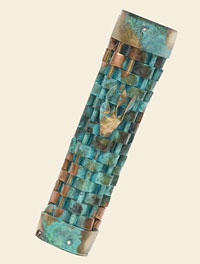Gary Rosenthal Collection: Contemporary Judaica Art Rooted in Tradition
 Mezuzah with patina
Mezuzah with patina Photograph courtesy of Gary Rosenthal
When Gary Rosenthal dropped out of college for a year to work for his father, a stove repairman, he never knew it would ignite his affinity for copper. But one day, when Rosenthal was torching a cast iron stove's heavy grates, something clicked.
"I pretty much I fell in love with fire at that point," he says offhandedly. During this time he also tinkered with metal sculpting, then went back to college to obtain his degree in Industrial Labor Relations from Cornell University. He showed his handiwork to a metal artist professor who bluntly told Rosenthal he didn't possess any sense of aesthetics, color, form, light or shape. As he waited for the final insult, the professor said, "People are going to love your work and it will sell like crazy."
Today, that has proven to be an understatement.
"I'm self taught, but I have a knack for making things people like," Rosenthal admits. He started making artistic pieces out of copper sheets, cut nails and steel rods; figurines of "people doing things," as he puts it. Like a fully formed one inch figure "skiing" down white limestone, or a 50 pound rock with two figures on it with a thin copper wire between them so they looked like rock climbers. He was showing his work at a Jewish community center in Baltimore and someone asked him to make a menorah. So he set out to make several, and they all sold out like proverbial hotcakes. Rosenthal soon realized his niche and quickly filled the need for people in search of handmade copper Judaica, like menorahs, candlesticks, goblets, Seder plates and other objects for use in temple ceremonies or in someone's home.
 Copper dreidel
Copper dreidel Photograph courtesy of Gary Rosenthal
"We were ahead of the curve and we dominated the market," he says. "After WWII America became such a nice open place to live that people began to feel comfortable and at that point Judaica was a market niche that needed to be filled. I know the houses were empty of Judacia because mine was." At his zenith he employed 50 people working overtime to keep up with demand. "When I first got started I went to the junk yard and got copper scrap, but now we buy a couple of tons of sheet copper each year," he says. That sheet is often 16 or 20 ounce from roofing supply companies, even up to 1/8 inch plate. But copper markets have changed and copper is now sourced from all over. "I prefer to get materials from this country as it's been my experience that the quality is higher," he admits, speaking of some frustrating experience with foreign brass. For his sheets he will cut it down, punch it out to create details on his pieces, even using 3/8 diameter copper wire. And his collection of Judaicia is very contemporary, exuding a playfulness with his use of form and colored copper, something his old art professor would be proud of.
All the U.S. presidents since Jimmy Carter, and other heads of state, have received his work as gifts from other heads of state. Recently a group of Jewish diplomats on the way to Abu Dhabi, Dubai, and Morocco commissioned Gary to make a set of dreidels each with personalized plates the tops can spin on, which were then given to prime ministers. "Of all the metals we work with, stainless steel, bronze and brass, copper's my favorite, the way it looks, the way we can color it both hot and cold," he says. "You go all the way back to the original ark of the covenant and copper was used on it." Copper therefore has a sacred background. "For me, its God's metal," he says.
Is addition to finding his work at stores nationwide, his work is also available in such noted museum gift shops like the Smithsonian's Renwick Gallery, Corning Museum of Glass in New York, the American Craft Museum, Skirball Museum of Culture in Los Angeles, and the John F. Kennedy Center for the Performing Arts.
Resources:
Also in this Issue:
- Nicholas Toth Dives Deep into His Grandfather's Art
- Phoebe Adams Fine Art: Finding the Balance
- Gary Rosenthal Collection: Contemporary Judaica Art Rooted in Tradition
- Rob Koehl: Serendipity Through Copper
- Cantor Arts Center at Stanford University Receives Two Major Bronze Sculpture Acquisitions
